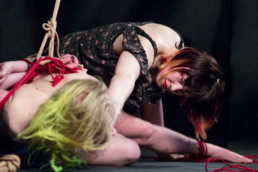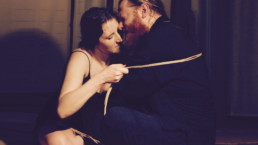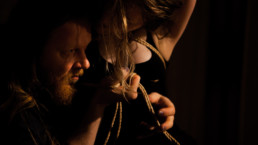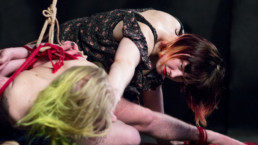Interview with Ceci Ferox
Dear Ceci, how did you get started with shibari?
Tying & getting tied up is one of my core fantasies since childhood. I got more sucked in to the Japanese side of bondage about 10 years ago.
What is your approach to shibari?
I am super nerdy about everything from rope manufacturing to creating connection and play. Analytical, motivated by learning, comforted by rules, intuitive, creative.

Tying & getting tied up is one of my core fantasies since childhood.
Ceci Ferox
Tell us about a constant that keeps you coming back to shibari?
It keeps me sane, it gives me moments of meditation and connection.
Who are or what are you inspired by from practicing shibari?
The connective abilities of Hedwig, the scientist in Georg Barkas, the chaotic energy in Tifereth and the movement of contemporary dance. The strength, personalities and imagination of my partners. Breaking the rules by the power of queer. Grotesque, therapeutic and transformative forces of rope.
How do you continue to challenge yourself, within the frame of shibari, as it grows in popularity and attention?
I seek to answer the question “why?” and learn through my experiences. I seek inspiration from teachers, but with moderation and intention: most of the time I attend classes with the sole purpose of having fun. I want to allow my growth to happen organically, not forced, not fast. Slow like a tree, steady.
I seek inspiration from teachers, but with moderation and intention: most of the time I attend classes with the sole purpose of having fun. I want to allow my growth to happen organically, not forced, not fast. Slow like a tree, steady.
Ceci Ferox
What are the things you love the most about shibari?
It’s an endless world of learning and invention, the joy of exploration.
What are the things you dislike the most about shibari?
Dogmatism, one true ways, hero and authority worship.
What would you like to show/teach others about shibari?
Understanding of the underlying principles that are common to all styles of shibari so people can start asking why instead of how.
Name some of your essential resources:
My teachers (my tying partners and the people i have studied with privately or in workshops), my dance practice, my rope community in Helsinki.
Thank you very much! We are really looking forward to it, too.
(Title Photography by Hans Erik Unneland)
Read other Interviews
Interview with Addie
Dear Addie, how did you get started with shibari?
I started with a partner who was interested and quickly discovered that I enjoyed it, both tying and being tied. I met Barkas a couple of years later at our local kink convention and things snowballed from there.
What is your approach to shibari?
As a person who ties, I want my tying partner to trust me, themselves, and the situation enough to relax the facade of socially acceptable speech and behaviours that we all wear to function in our societies. As a person who is tied, I look for the reciprocal state, moments or situations where I can drop the need to control or to behave, and let my mind or my body or my breathing react as they will. I want to find interactions where I lose track of time. As a person who self suspends, I want to push myself and see what I am capable of under pressure, and where the edge is, and how close I can get to it.
I look for the reciprocal state, moments or situations where I can drop the need to control or to behave, and let my mind or my body or my breathing react as they will.
Addie

Tell us about a constant that keeps you coming back to shibari?
It provides a space outside of day-to-day routine and preoccupation, where people can explore themselves. At its best, Shibari gives people the opportunity to be unscripted in their reactions, and to learn about themselves from the sources of those reactions.
Who are or what are you inspired by from practicing shibari?
Barkas has definitely been my largest influence and inspiration. They have a way of creating metaphors for rope practice that sound bizarre at first but end up making a lot of sense on further inspection. I love seeing what they will come up with next, and I love being along for the ride.
How do you continue to challenge yourself, within the frame of shibari, as it grows in popularity and attention?
I don’t really find its growth in popularity to be a problem, and it doesn’t negatively affect my personal practice. More interest and popularity has its pros and its cons (I think there are more pros) and as someone who teaches I am happy that there are people who want to learn, especially since I love teaching beginners. For myself, there are times of progress and then periods where I feel stagnant, then another period of growth, the same as learning any other craft. If I feel that I am in a period of stagnation then I take a break from tying for a couple weeks, and that tends to fix things. Pushing oneself to be constantly improving is impractical, especially as the better one is at a skill the smaller the progress steps are.
Pushing oneself to be constantly improving is impractical, especially as the better one is at a skill the smaller the progress steps are.
Addie
What are the things you love the most about shibari?
It has the potential to help people practice conscientious, kind, and impactful human interactions. Observing someone and trying to understand them requires a calm, supportive, patient empathy that we don’t necessarily have a chance to exercise in daily life, except perhaps with dear friends. Spending time trying to understand another helps exercise empathy muscles, so to speak, and that can only be a good thing. Exploring taboos (and bondage is certainly a taboo) also asks us to address what is uncomfortable in ourselves, and hopefully lets us deconstruct insecurities, biases, fears, and other dark bits that don’t often get examined.
What are the things you dislike the most about shibari?
It can be used in ways that I find highly unethical, for the benefit of one person at the expense of another. It requires physical and emotional vulnerability, and I think that people, generally very well-meaning people, sometimes run too deep too quickly and unearth things that they do not then have the time, energy, or support systems to deal with without undue distress.
What would you like to show/teach others about shibari?
This may sound cheesy but I think that giving someone the space to find and address the bits of themselves that they are most unsure of, and then celebrating those things with them, is a kind of love that builds people up, and that many of us don’t get enough of. I would like to show people how to practice sharing that type of affirmation, of caring for someone including their flaws, not in spite of them.
Name some of your essential resources:
Barkas, definitely. I’ve learned most of what I know about rope from them, though I have my own way of using some of those tools. Other than that, lots of conversations with lots of people, and years of seeing a variety of good or less good situations in rope. That collection of experiences, which is still growing, is the basis for most of what I believe matters in Shibari.
Thank you very much! We are really looking forward to it, too.
(Title Photography by Helene Planquelle)
Read other Interviews
Interview with Barkas
Dear Barkas, how did you get started with shibari?
I saw the facial expressions of a close person and was mesmerized. I wanted to be able to create such facial expression and a week later I signed up for a beginner workshop. Ever since then I am into tying more than anything else.
What is your approach to shibari?
It is hard to say. I don’t think I have one explicit approach to Shibari. Like everyone is different and unique, I try to tie with everyone in a way that suits them and us. If I had to boil it down, I would say, that my approach is a very communicative one that draws from more than just patterns and aesthetics. I tie because I want to get to know the other person. Knowing as in getting an understanding of what moves them.
I tie because I want to get to know the other person. Knowing as in getting an understanding of what moves them.
Barkas
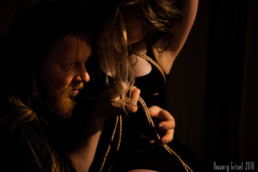
Tell us about a constant that keeps you coming back to shibari?
It is the single most interesting field I have encountered. No other practice in my life was so diverse and had room for so many perspectives as Shibari is.
Who are or what are you inspired by from practicing shibari?
I try to draw my inspiration from an as far as possible range of different fields. As for Shibari people, there is of course my teacher Yukimura Haruki. The other person that I draw inspiration from in Shibari is Pilar. I don’t know her teachings or her approaches but watching her and talking to her made me questioning the dimensionality of rope itself.
Other inspirations are for sure several philosophers of the French poststructuralist tradition (Derrida, Barthes, Bachelard, Lyotard) as well as some phenomenologists such as Judith Butler and Sara Ahmed.
Architecture is a great inspiration as well as nature itself.
How do you continue to challenge yourself, within the frame of shibari, as it grows in popularity and attention?
My way of practicing and teaching Shibari is to embed it in a greater context. I am constantly surprised how much there is that haven’t been thought of yet. My way of challenging myself is to constantly question myself. What is it that I might see from a less ideal angle? And to learn from that reflection.
My way of practicing and teaching Shibari is to embed it in a greater context. I am constantly surprised how much there is that haven’t been thought of yet.
Barkas
What are the things you love the most about shibari?
I feel like it can hand people an image of possibilities that is potentially harmful without acknowledging that possibility. I think that this opens the door for people who have at the least questionable motives. I dislike that it is often not only brought in a close relationship to sexuality but, it seems, it is often confused with sex which leads me to point one.
I think, rope itself, or Shibari, “is” nothing. It is what we fill it with, be it art, sexuality, sport, crafts, meditation, therapy, whatever. I feel like people not accepting this diversity is what I dislike most about Shibari.
What would you like to show/teach others about shibari?
I would like to teach what I think rope can do: Basically anything but mostly that it can be used as a tool to truly and honestly interact with another human being on a level that is not really possible through spoken language. I would like people to see what I have seen.
This and patience 🙂
Name some of your essential resources:
The only resource of essence is life itself and what we have encountered in it. I think that the people who inspire me are also my resources. Of course, I was for a long time (almost a decade) student of Osada Steve and that had an immense impact on my tying but the few years with Yukimura Sensei who taught me to listen and to see were incommensurable and I still see them as resources. My books are a resource. When I think more about it I think I have to say that my greatest resource is always the person I tie with in that particular moment.
Anything else you'd like to add?
We are very much looking forward to teaching the concept of Barkas’ Kinbaku City in Berlin because I think that the people there are very perceptive for this kind of metaphors and poetics. At least in my experience.
Thank you very much! We are really looking forward to it, too.
Read other Interviews

